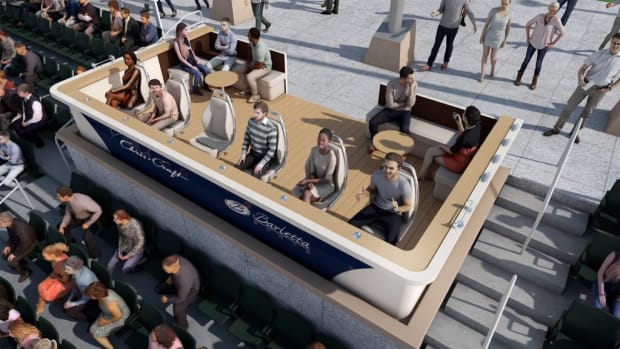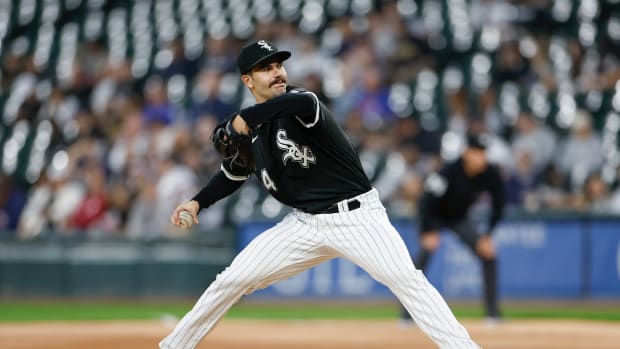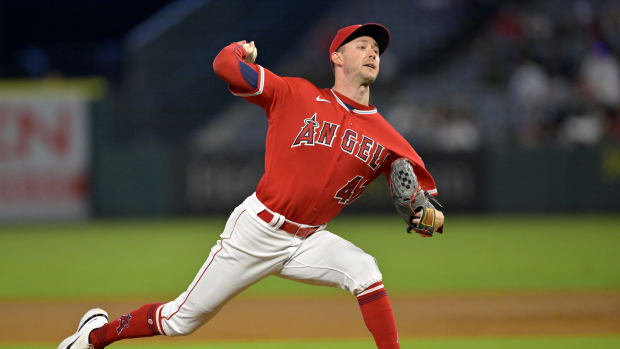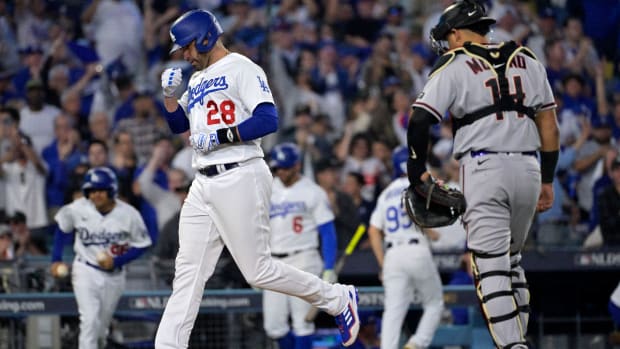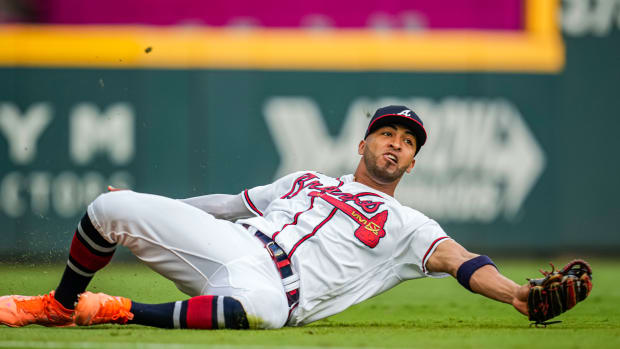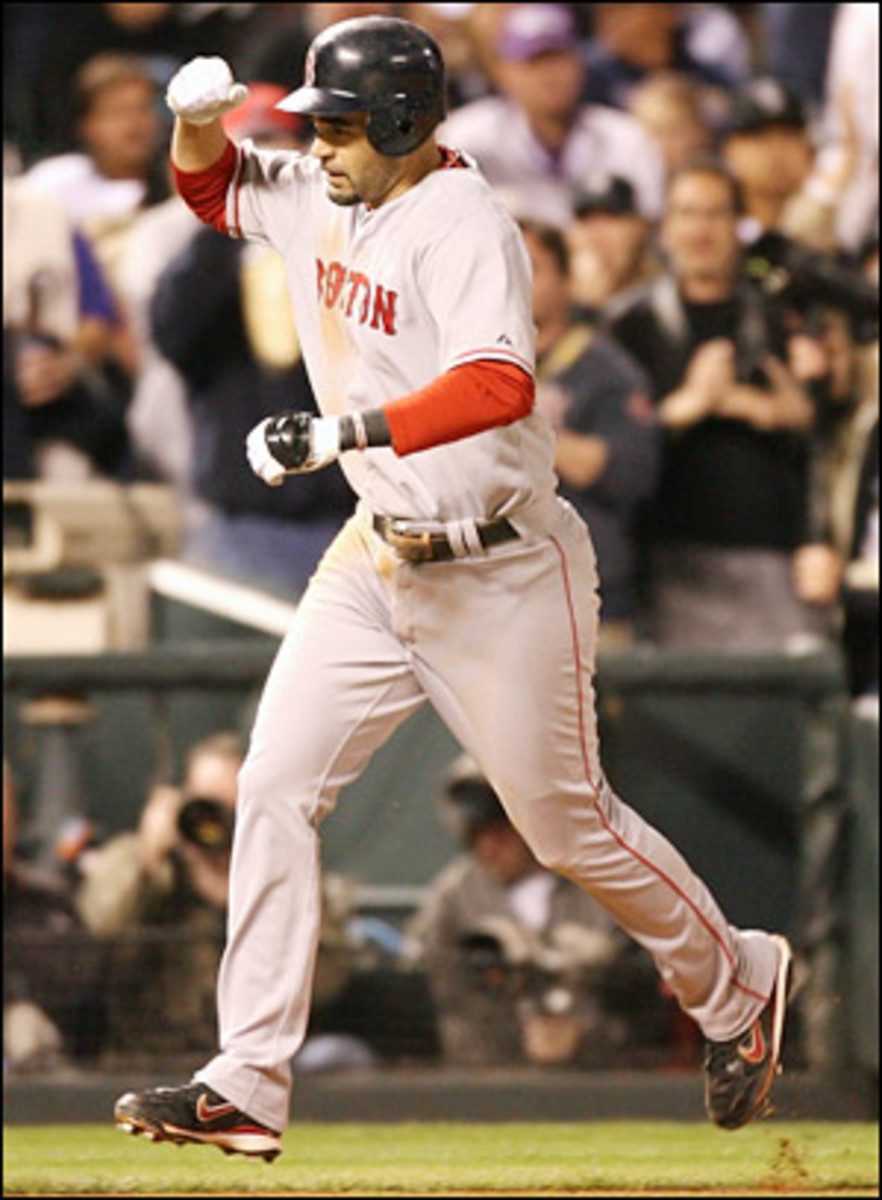
AL East Hot Stove Preview
Winter madness is starting early this year, thanks to the Red Sox's World Series sweep and Alex Rodriguez's opt-out clause.
I've put together my predictions and suggestions on the general direction that each team is going to take, which can range from a "strong buy" (trading in cash and long-term assets to win in 2008) to a "strong sell" (just the opposite).
For each club, I've provided both a recommended and a predicted course of action; the latter is generally based on a top-level read of a team's behavior rather than any sort of insider information. There's also an abundance of information on long-term contracts, most of which is borrowed from the invaluable Cot's Baseball Contracts.
One quick note: the category for "key ready-now youngsters" is generally limited to players who have not yet broken into their team's everyday lineup, or who only did so in the middle of the 2007 season. The series starts with the AL East:
2007 Record: 96-66, 1st in AL East2007 Attendance: 3.0 million, 4th in American League2007 Payroll: $143 million, 2nd in baseballKey Free Agents (2007)3B-R Mike LowellSP-R Curt SchillingRP-R Eric GagneRP-R Mike TimlinSP-R Matt Clement1B-L Eric HinskeC-R Doug MirabelliSP-R Tim Wakefield (club option)SP-R Julian Tavarez (club option)Key Free Agents (2008)C-B Jason VaritekRP-R Brendan DonnellyINF-L Alex CoraLF Manny Ramirez (club option)RP-L Hideki Okajima (club option)Key Long-Term CommitmentsRF-L J.D. Drew, $14m/year through 2011DH David Ortiz, $12.5m/year through 2010, plus 2011 club optionSP-R Josh Beckett, $10m/year through 2009, plus 2010 club optionSS-R Julio Lugo, $9m/year through 2010, plus 2011 vesting optionSP-R Daisuke Matsuzaka, $8.8m/year through 2011CF-B Coco Crisp, $5.25 m/year through 2009, plus 2010 club optionKey Ready-Now YoungstersCF-L Jacoby EllsburySP-R Clay BuchholzSP-L Jon LesterOF-L Brandon MossSS-B Jed LowrieSP-R Justin MastersonSP-R Michael BowdenRP-R Craig HansenNeeds: 1. 3B, if Lowell departs; 2. Perhaps SP, if Schilling departs.
What They Should Do:Weak Sell. The Red Sox can give away talent and still have the best 2008 club in baseball, perhaps along with the Indians. I would certainly re-up Wakefield, whose option is cheap, and make reasonable effort to re-sign both Schilling and Lowell. But there are reasonable contingency plans if they're asking for too much money. If Schilling departs, you could still have a very capable rotation of Beckett/Matzusaka/Buchholz/Wakefield/Lester. If Lowell leaves, you could move Kevin Youkilis to 3B, David Ortiz back to 1B, Manny Ramirez to DH, and go with an outfield of Ellsbury/Crisp/Drew. That would give up quite a bit of infield defense, but would make most of it back up in the outfield. Alternatively, if you re-sign Lowell, you can trade Crisp for a prospect, targeting a corner outfielder or a catcher. Either way, the Red Sox should be getting a little cheaper and a little younger, while at most marginally affecting the quality of the 2008 team. A more severe iteration of this plan would be to deal Julio Lugo and give Jed Lowrie the shortstop position, but the Red Sox will probably need to wait for Lugo to have a better season and regain some trade value before they can do that.
What They Will Do:Hold. I'd guess that in the wake of his World Series MVP, the Red Sox will be willing to apply the precedent they established for Jason Varitek, and give Lowell one more year on his contract than they might give him otherwise. I'd also guess that if Schilling goes -- and he's more likely to leave than Lowell -- the Red Sox will target some sort of No. 4 starter in the free-agent market. Both of these are perfectly defensible decisions.
Doing something drastic like going after Alex Rodriguez, on the other hand, is neither particularly defensible nor particularly likely. The Red Sox do well enough on the field, at the gate, and in player development that they have little reason to overpay for someone when there are palatable alternatives, and this is the one environment where I think concerns about A-Rod's clubhouse and media distractions are tangible enough to weigh into your decision.
2007 Record: 94-68, 2nd in AL East2007 Attendance: 4.3 million, 1st in American League2007 Payroll: $190 million, 1st in baseballKey Free Agents (2007)3B-R Alex RodriguezRP-R Mariano RiveraSP-R Roger ClemensRP-R Luis Vizcaino1B-L Doug MientkiewiczC-R Jose MolinaC-B Jorge Posada (player option)SP-L Andy Pettitte (player option)RF-L Bobby Abreu (club option)Key Free Agents (2008)SP-R Mike MussinaRP-R Kyle FarnsworthDH-L Jason Giambi (club option)SP-L Carl Pavano (club option).Key Long-Term CommitmentsSS-R Derek Jeter, $20.3m/year through 2010OF-L Johnny Damon, $13m/year through 2009LF-L Hideki Matsui, $13m/year through 2009SP-L Kei Igawa, $4m/year through 2011Key Ready-Now YoungstersSP-R Joba ChamberlainSP-R Phil HughesSP-R Ian KennedyOF-B Melky Cabrera3B-B Wilson BetemitSP-R Allan HorneOF-R Shelley DuncanSP-R Tyler ClippardRP-R Edwar RamirezNeeds: 1. 3B; 2. C, OF, and Closer, depending on who departs; 3. 1B
What They Should Do:Weak Sell. It's safe to assume that no team has ever had this much talent coming off the books at any one time. So let's start by considering what assets the Yankees still have locked into place. The starting rotation should not need Andy Pettitte to return, nor really any help at all. A staff consisting of Chamberlain, Kennedy, Hughes, plus veterans Chien-Ming Wang and Mike Mussina, could be one of the better groups in the American League, and has ample backups in the form of Clippard, Igawa, Horne, and possibly Carl Pavano. Yes, there are contingencies where several things could go wrong, but that's just as true for the other 29 MLB clubs. The middle infield, with Derek Jeter and the strangely underrated Robinson Cano, is rock-solid. Jason Giambi is back in the DH slot, if he can stay healthy. An outfield of Damon, Cabrera and Matsui, with Shelley Duncan a candidate for work against left-handed pitching, is probably about league average.
Let's say that the Yankees part ways with all their free agents. That would imply going with Wilson Betemit at 3B, and probably Duncan at 1B. It would mean being willing to tolerate a year of Kyle Farnsworth as your closer, or perhaps hoping to get big things out of Edwar Ramirez, who struck out 15.4 batters per nine innings (!) between three professional levels this year. There's nothing at all at catcher, so we would allow the Yankees to sign a middling free agent along the lines of Michael Barrett at that position.
How bad would that team be? Not as bad as you might think. It looks like about an 86-88 win team from here, although with a high degree of variance on either side of that estimate because so much of the talent is either very young or very old. I should pause here to note that I'm a fairly big fan of all three of Chamberlain, Kennedy and Hughes -- not just in the long-term but also in the near-term -- and a believer that players like Betemit, Cabrera, Duncan and Ramirez are better than they're given credit for, albeit probably below league average relative to their positions. It's a group that would reach the playoffs -- I don't know -- 30 percent of the time, and occasionally back into 98 wins, making Joe Girardi the biggest hero in New York since Fiorello LaGuardia.
But, it wouldn't be the juggernaut that Yankees fans are used to, and so what the club needs to ask itself is whether it's willing to tolerate being merely decent for a year instead of being dominant. Of course, there is a lot of middle ground between this "worst case" scenario and the Yankees throwing money at any player who will take it. In evaluating these alternatives, the Yankees ought to abide by two guiding principles:
Let's not make silly long-term contract commitments, of the sort we're finally getting out from when the Giambi and Pavano contracts terminate at the end of the 2008 season.
Let's not block or trade young talent at places where we have it.
This would rule out going after a player like Torii Hunter, who is likely to be overpaid, and for that matter Mariano Rivera, who isn't going to cut the Yankees any bargain. It would imply providing players like Cabrera, the three young starters, and perhaps Betemit with the benefit of the doubt as they try and entrench themselves in the lineup. Here is one riff on that strategy:
Part ways with Bobby Abreu, whose $16m option could be better spent elsewhere.
Probably part ways with Rivera, although they can be flexible on this decision if the price is right. Instead, I would sign a left-handed reliever like Ron Mahay, and let Ramirez and Farnsworth fight for the closer's job, ready to make a move at the trade deadline if no solution has emerged by then, and ready to consider options involving Joba Chamberlain if nothing else is working out.
Hope that Andy Pettitte does not pick up his option. If he does, I would definitely punt on Rivera and probably make Chamberlain my provisional closer out of spring training, ready to reverse that decision as events dictate.
Go ahead and re-sign Posada, being willing to overpay slightly given the lack of alternatives in the organization.
Sign Mike Lamb to challenge Betemit. If Betemit hits well enough to earn both sides of a platoon, we can still get Lamb 200-300 PA in various roles.
Here's the big one: sign Barry Bonds. New York is big enough to absorb any distraction that Bonds might provide, and he'll likely be one of the biggest bargains in the market. More important, he won't be seeking more than a one- or two-year contract. That gives us Bonds, Damon, Matsui, Cabrera, Giambi, and Duncan in some kind of rotation between the three outfield positions, 1B and DH. Either Bonds or Matusi is going to need carry a first base mitt with him, and we will rotate the assignments depending on who is healthy and who is hitting.
I would still term this a "weak sell," because it implies that we're going to be cutting payroll back down to the $150 million range (see table below). But we're still going to have something between a very good team and a great team, and there will be plenty of personalities to keep fans and media engaged all season.
What They Will Do:Hold. This question is no easier to answer than the previous one. By "hold" I mean that the Yankees will not be willing to tolerate a rebuilding year -- they will set a target of about 95 wins, as they usually do. I do not mean that the Yankees will stand still, since they will necessarily need to shell out some money (or prospects) to replace A-Rod and company. But this is at best a speculative conclusion, which raises several related questions:
1) What will Hank & Hal Steinbrenner do, if they dictate the strategy?
The mishandling of the Joe Torre situation has Hank & Hal's fingerprints all over it, and it could lead one to a couple of different conclusions about their way of doing business. In particular, they are impatient, penny wise and pound foolish, and not particularly competent baseball men. That would imply the Yankees running around like headless chickens, in on the bidding on just about everyone, and sort of reverse-arbitraging their way to some bad decisions where the Winner's Curse kicks in.
2) What will Brian Cashman do, if he dictates the strategy?
In contrast to the "firing" of Joe Torre, the hiring of Joe Girardi looks more like Cashman's work. Don Mattingly's calling card was the continuity he implied. He was an internal hire with nearly as much stature within the organization as Torre, and he has a more deferential personality than Girardi. Mattingly was the business-as-usual hire. On the other hand, one could imagine him becoming crestfallen if the Yankees failed to meet expectations. Girardi, by contrast, has a reputation for working with young players, and under ambiguous objectives from the front office. That is more the hire to make if you're prepared to move on to Yankees v2.0, perhaps with 2008 serving as the beta test. This would imply that Cashman would prefer something more along the lines of my strategy.
3) Who is actually dictating the strategy?
I don't know, and since the situation has been so fluid, I don't know that anyone else does either. But one noteworthy factor is that Cashman is on the last year of his contract, which would suggest that he might need to be more concerned about keeping Hank & Hal happy than the long-term fitness of the organization.
4) Would the Hank & Hal strategy actually make the Yankees a better ballclub in 2008 than the Lies, Damned Lies strategy?
Perhaps not. Even with all the talent the Yankees have lost, the talent they still have on hand is relatively efficiently configured -- there are few redundant assets, and there are capable young players at the positions where they need them the most. So the risk is that Hank & Hal adopt a number of inefficient solutions, like re-upping Abreu when they could have Bonds or perhaps Adam Dunn for the same money, or signing Carlos Silva when he's actually a downgrade versus Ian Kennedy, or letting Rivera go, but replacing him with some mediocrity like Todd Jones. Even worse, they could trade away some premium young talent. With A-Rod crossed off their list, and Mike Lowell quite possibly not being available, talent at third base is very thin, and the Yankees will either have to be willing to go with a solution like Lamb/Betemit or will have to make some sort of trade. If Billy Beane pulls off some monster heist like Kennedy, Ramirez and Duncan for Eric Chavez, I would not be entirely surprised.
2007 Record: 83-79, 3rd in AL East2007 Attendance: 2.4 million, 7th in American League2007 Payroll: $82 million, 17th in baseballKey Free Agents (2007)1B-L Matt StairsRP-L Joe KennedyKey Free Agents (2008)RP-L Scott Downs3B-R Troy Glaus (player option)SP-L A.J. Burnett (opt-out provision)DH-R Frank Thomas (vesting option)C-B Gregg Zaun (vesting option)Key Long-Term CommitmentsCF Vernon Wells, $18m/year through 2014SP-R Roy Halladay, $13.3m/year through 2010RP-L B.J. Ryan, $10m/year through 20101B Lyle Overbay, $6.6m/year through 2010SS John McDonald, $1.9m/year through 2009Key Ready-Now TalentLF-L Adam LindC-R Curtis ThigpenSP-R Jesse LitschSP-R Josh BanksSP-L Ricky RomeroNeeds: 1. SS; 2. Possibly 1B; 3. Star-quality talent
What They Should Do:Weak Buy. Three features of this club to demarcate before we move forward. Firstly, the Blue Jays' needs are a little hard to identify, because they're locked into talent that rates somewhere around league average at an abnormally high number of positions. Secondly, look at all the silly things that the Jays have going on with their long-term contracts. You've got a player option for Glaus, an opt-out clause for Burnett, and vesting options for both Thomas and Zaun, all four of which could come back to haunt the club. By contrast, look at how many club options the Indians have. The difference between club options and player options is enormous from a valuation standpoint, and the fact that the Blue Jays have so many of the latter is an indictment of their financial acumen. Thirdly, the Blue Jays have very little high-upside minor league talent. Travis Snider is the one exception, but he's too far away to be a consideration in the near-term; after that you have guys like Lind, Thigpen, and Litsch, who are probably battling to be league-average players.
What all this adds up to is that the Blue Jays are damned if they do and damned if they don't. If they want to rebuild their farm system, the one really tradeable asset they have is Burnett, who could probably fetch them at least one Grade-A prospect. But that would still leave the glass of the 2010 Blue Jays no better than half-full, while ruining any hopes of contention for this year, and rending a lot of the big-dollar veteran contracts pointless. They could conceivably also try and move Halladay, but they run into largely the same problems, while also risking provoking a fan backlash. On the other hand the Blue Jays could potentially try and throw money at positions like 1B and LF, but they'd either have to be willing to write off a sunk cost (Overbay) or a sunken prospect (Lind).
Faced to choose between the lesser of two evils, I would probably go the buy route and re-sign Stairs -- he should not cost them very much -- and make a play for help at the shortstop position, perhaps trading bullpen talent for someone like Jack Wilson, or seeing what Billy Beane would want for Bobby Crosby. David Eckstein also makes more sense here than he does in many places. Both the rotation and the bullpen, at least, ought to be pretty good, especially if B.J. Ryan and Brandon League get back to full strength. The Blue Jays will still need some help to reach the playoffs under this scenario -- perhaps a year where they outperform their Pythagorean record, or perhaps a flop from the Yankees -- but they'll at least nominally be in contention, and the fanbase seems to be responding more favorably to this sort of strategy than they did to J.P. Ricciardi's rebuilding days.
What They Will Do:Hold. Ricciardi has already stated that he expects it to be a quiet winter, which reminds one that the definition of insanity is trying the same thing over and over again and expecting different results. Granted, this is not an easy hand to play -- a lot of the Blue Jays' long-term contracts are cumbersome enough to inhibit creative redesigns. But, upgrading the shortstop position from replacement level to league average would increase the Jays' chances of reaching the playoffs from perhaps 10 percent to 20 or 25, and that's worth something for a franchise that could use a kick-start.
2007 Record: 69-93, 4th in AL East2007 Attendance: 2.2 million, 11th in American League2007 Payroll: $94 million, 10th in baseballKey Free Agents (2007)CF-L Corey PattersonSP-R Kris Benson (club option)Key Free Agents (2008)LF-R Jay PaytonKey Long-Term CommitmentsSS-R Miguel Tejada, $13m/year through 20093B-R Melvin Mora, $8.3m/year through 2009, plus 2010 club optionDH Aubrey Huff, $8m/year through 2009C-R Ramon Hernandez, $7.75m/year through 2009, plus 2010 club option2B-B Brian Roberts, $7.15m/year through 2009RP-R Danys Baez, $5m/year through 2009OF-L Jay Gibbons, $5.6m/year through 2009RP-L Jamie Walker, $4.5m/year through 2009RP-R Chad Bradford, $3.5m/year through 2009Key Ready-Now TalentC-R Matt WietersSP-L Adam LoewenSP-L Garrett OlsonRF-R Nolan ReimoldNeeds: 1. Front Office; 2. CF; 3. LF; 4. SP depth; 5. 3B; 6. Closer
What They Should Do:Strong Sell. Wow, the Orioles have a lot of dink-and-dunk little contracts that somehow added up to the 10th highest payroll in baseball. Nevertheless, I think I'd rather be in their shoes than those of the Blue Jays. Almost all of the contracts are coming off the books after 2009, and there's a little more high-upside talent in the form of guys like Weiters, Nick Markakis and eventually Billy Rowell. I don't include Erik Bedard in that group because unfortunately he'll hit his free-agent cycle after 2009 as well; otherwise 2010 would be the year you'd target.
Nevertheless, I think you need to dispatch what assets you can. The middle infield of Miguel Tejada and Brian Roberts is the Orioles' one true strength, but those are also two contracts that ought to translate to quite a bit of trade value. The other player with some surplus value, of course, is Bedard, who might have one of the most favorable contracts in baseball over the course of the next two seasons. In theory, Bedard ought to have more trade value than Johan Santana; whether the market feels that way is an open question, but you're certainly liable to do pretty well for him. This is one case where I'm willing to let things get really ugly in 2008 and 2009, not even worrying about the surface major league talent. I'd also recognize the sunk costs of players like Payton and Mora and hope to hit the lottery with a couple of freely-available talent singings, as the Devil Rays did last year with Carlos Pena.
What They Will Do:Weak Sell. Most of all, this team needs a front office makeover, and a GM who is empowered to make tough decisions. I suspect that the Orioles will at least recognize that they aren't close enough to contending to spend any more on free agents, but also that they'll be a little too passive in their rebuilding efforts, tending to field calls from other GMs rather than making them themselves.
2007 Record: 66-96, 5th in AL East2007 Attendance: 1.4m, last in American League2007 Payroll: $24 million, lowest in baseballKey Free Agents (2007)DH-B Greg NortonRP-R Al Reyes (club option)Key Free Agents (2008)RP-R Dan WheelerLF Carl Crawford (club option)CF Rocco Baldelli (club option)Key Long-Term CommitmentsINF Akinori Iwamura, $2.8m/year through 2009, plus 2010 club optionBaldelli and Crawford also have revolving club options through 2011 and 2010, respectively.Key Ready-Now Young Talent3B-R Evan LongoriaSP-L David PriceSP-L Jacob McGeeSS-L Reid BrignacSP-R Wade DavisRP-R Jeff NiemannSP-R Andy SonnanstineSP-R Chris MasonINF-R Joel GuzmanSS-B Ben ZobristSS-R Josh WilsonOF-L Chris Snelling.Needs: 1. SP, but only in the very near term; 2. RP, 3. C.
What They Should Do:Weak Buy. Let's fast-forward a year and introduce your 2009 Tampa Bay Devil Rays.
That, my friends, could be one hell of a baseball club. This is the rare, idyllic instance of a team with a half-dozen franchise talents that will all have the chance to grow up together. Note the inclusion of Pedro Alvarez, the likely No. 1 1 pick in the 2008 draft, whose natural position is third base but won't have the chance to play that position in this organization; either way, he could wield an Albert Pujols type of bat. I've also taken the liberty of playing B.J. Upton at second base and holding on to Rocco Baldelli through the first of several option years; Akinori Iwamura at 2B and Upton in center is the more likely alternative. Finally, I've listed Jeff Niemann as the closer because I think with his injury history he profiles well for a change of routine, but it's too early to guess at that for now.
Can this team contend in 2008? I don't think it's completely out of the question -- all of these players are talented, and all of them are close to major-league ready -- though it will depend on how quickly they're willing to promote guys like Longoria, Price, and McGee. Is that chance tangible enough to make a surgical strike in the free-agent market? What I would not do is spend any money at all on starting pitching talent, which will be considerably overpriced this winter. However, I would consider making upgrades at two positions. The first is catcher, where Dioner Navarro is the ugly duckling in this dream lineup. I'd at least give passing thought to signing Jorge Posada if he becomes available, with an eye mainly toward helping to mentor the young pitching staff. And I'd consider signing a high-upside reliever along the lines of Eric Gagne or Kerry Wood, perhaps at $3 million with two team option years priced at $6 million and $7 million respectively; they could help the starters to accumulate a few more wins while relieving any pressure on Joe Maddon to run up his pitch counts. With both signings, the strategy is mostly to make a preemptive play for 2009, but if I "accidentally" wind up helping my team to stay in the thick of things until August or September this year, that's hardly a problem.
What They Will Do:Hold. I doubt that the Rays will agree with me on the merits of someone like Posada. But otherwise there's not a whole heck of a lot for them to do. Carl Crawford's name persistently gets mentioned in trade rumors, but he's an important enough part of the 2009 and 2010 club that the Rays are better off holding on to him unless they can get an amazing package.































